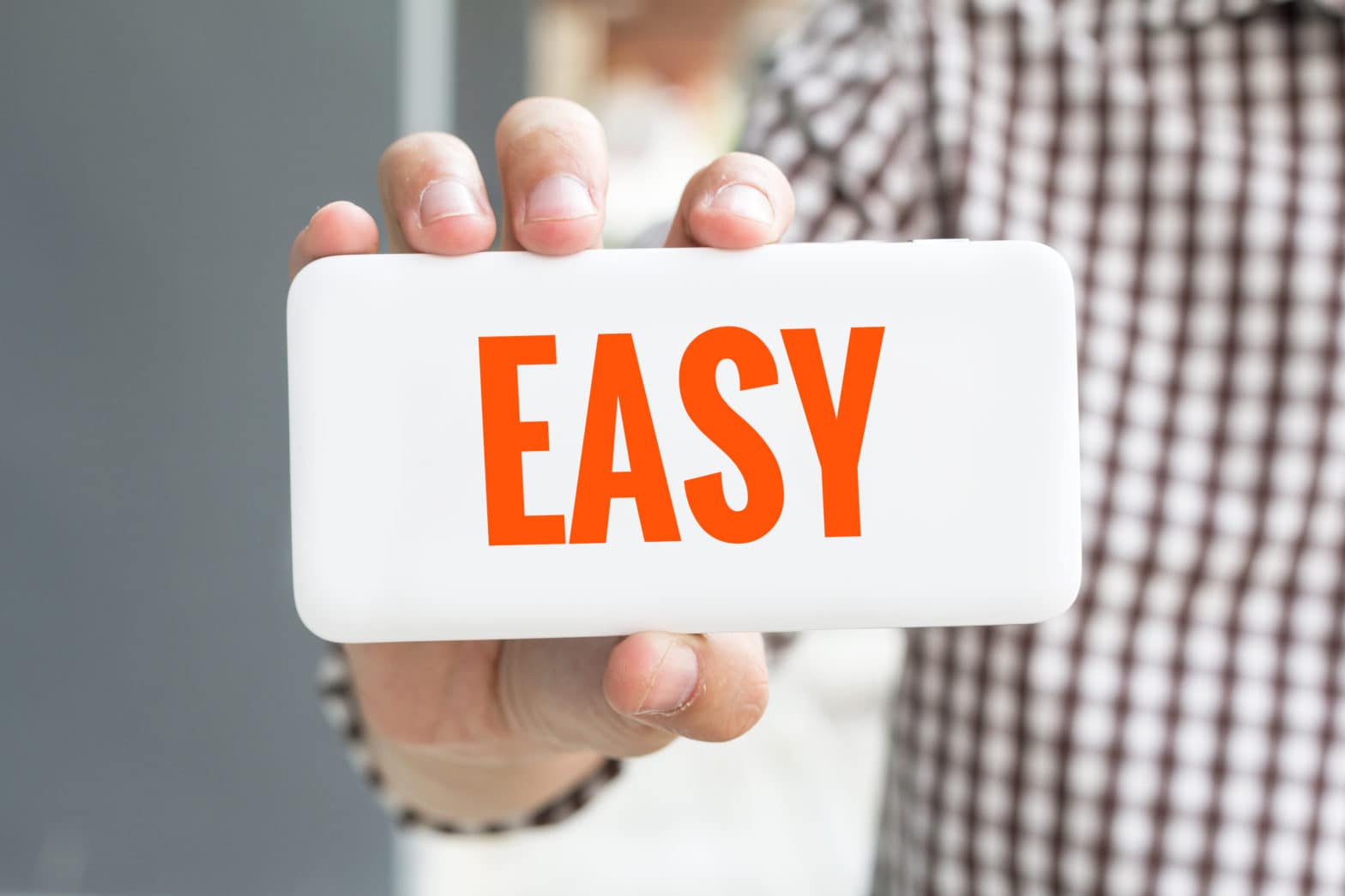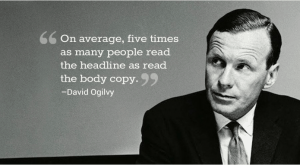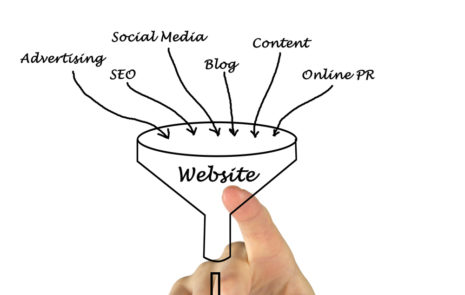
Top 100 Content Marketing Question: How to measure good content?
How does content make your reader’s job easy? To measure good content is the first question to ask.
It’s crucial to make content easy because human brains are lazy. People always seek the easiest, most effortless path to reward.
Maximize expectations of reward. Minimize effort.
Great content is:
- Easy to choose because the headline grabs you.
- Easy to scan because it’s made of bite-sized nuggets.
- Easy to read because it’s written at a grade-school level.
- Easy to believe because its message is completely consistent.
To ensure your content is as easy as possible for readers, measure good content 4 ways.
1. Easy to choose: the headline grabs you

As David Ogilvy said, “On the average, 5 times as many people read the headline as read the body copy. When you have written your headline, you have spent 80 cents out of your dollar.”
A great headline can outperform an average headline by as much as 500%, experts find. Great headlines get more clicks, more email opens and more engagement.
What readers prefer in headlines
A Conductor study found that readers prefer certain headline elements. Give readers what they want:
- Numbers in headlines
- Headlines with “you”
- “How to” headlines
- Normal headlines
- Question headlines.

Use magic numbers in headlines
Since readers like numbers, which numbers do they prefer most?
BuzzSumo’s study of 10 million B2B articles on LinkedIn found that headlines with the numbers 5, 10 and 3 are shared most.
Keep headlines short
Separately, BuzzSumo studied 100 million social media headlines.

They found that the most-shared content had short headlines:
- 9 words on LinkedIn
- 15 words on Facebook.
Test headline value
Headlines break through when they’re emotional, use numbers and employ power words.
Add power words to your headlines and content. Here’s how: “4 Ways to Use Power Words to Supercharge Your Message.”
Since headlines are key, write 20 headlines and test them to see which scores best. You can test the emotional marketing value (EMV) of headlines here.
EMV rates headlines on a scale of 0 to 100.
Set the bar high: aspire to achieve an EMV score of 40, 50, 60 or higher. For example, I wrote and tested 20 headlines for this blog.
Here are the EMV scores from each headline, in ascending order. Higher scores are better:
22 How to measure good content? 4 tips and tricks
30 How to measure good content? Make it easy, 4 ways
33 Q&A: How to measure good content?
38 Top 100 question: How to measure good content?
40 How to measure good content? Make it easier for readers
40 How to measure good content?
43 How to measure good content? 4 ways you can make content easy for readers
44 How to measure good content? Look through readers’ eyes
45 How to measure good content? 4 ways to make content easier
45 How to measure good content? 4 ways to maximize readers’ rewards
45 How to measure good content? See it as readers see it
50 Smart marketers ask: How to measure good content?
50 How to measure good content? Maximize readers’ rewards
50 How to measure good content? What readers do and feel
50 How to measure good content? 4 ways to see through readers’ eyes
50 How to measure good content? See through your readers’ eyes
50 Smart marketers want the answers: How to measure good content?
54 How to measure good content? Ideas to see through readers’ eyes 4 ways
56 Smart marketers are asking: How to measure good content?
56 How to measure good content? See through readers’ eyes
60 Smart marketers want to know: How to measure good content?
EMV makes it easier to choose the right headline, so you can more easily measure good content: “Smart marketers want to know: How to measure good content?”
Why do all this work? Because headlines with high EMV scores get clicked on more often, notes Andy Crestodina.

2. How to Measure Good Content – Make sure it’s Easy to scan, bite-sized nuggets
Most people spend less than 15 seconds active on a webpage. To keep readers going down the page, break up pages with subheads, images, captions, call-outs and bullet lists.
People don’t read much of the text on a web page, a Nielsen/Norman Group study found. They read half the words on a page with 111 words, but only 28% of words on an average web page with 593 words.

Which elements of content do people read most?
A study by Conversion XL found that people interact with short articles by zooming into particular elements:
- 97% read the headline.
- 98% look at the subhead.
- 91% read a caption that accompanies a photo.
- 60% finish a short article by skimming.
- Banner ads get <1.5 seconds of attention.
Takeaways to help you measure good content:
- Break up text into small bites.
- Make text easy to scan.
- Write and test headlines and subheads.
- Always include captions with photos.
- Don’t format crucial information as a banner ad; it won’t be seen.
3. Easy to read: written at a grade-school level
To test the readability of text, use the readability tool built into Microsoft Word. Or try a website such as readabilityformulas.com.
The lower the grade level of your text, the bigger the audience who can read and comprehend it. For example, this blog is written at a 7th-grade level, so more than half of people can comprehend it.
What do you gain with simpler text?
Use simpler text to:
- Achieve a grade-school level of readability (based on the Flesch-Kincaid test).
- Increase the number of people who can comprehend your text.
- Make text faster for everyone to consume.
- Help people speed up tasks.

For example, the Nielsen/Norman Group tested a pharmaceutical product website – before and after a rewrite to improve its readability. They found out that both lower-literacy and higher-literacy people benefit from high readability:

Lower-literacy audiences benefit from text that’s more readable:
- The success rate to complete a task nearly doubled, from 46% to 82%.
- Total time to complete 7 tasks fell from 22.3 to 9.5 minutes, saving users 12.8 minutes.
- Satisfaction increased from 3.5 to 4.4 (on a 5-point scale).
Higher-literacy audiences also gain from text that’s more readable:
- The success rate to complete a task increased from 68% to 93%.
- The total time to complete 7 tasks fell from 14.3 to 5.1 minutes, saving users 9.2 minutes.
- Satisfaction increased from 3.7 to 4.8 (on a 5-point scale).
How far can you push readability?
A company called Collective Health is pushing readability standards to the max. Its easy-to-read guides and manuals tackle the complex subject of health care insurance in plain English.
Collective Health writes at a third-grade level!
If they can write highly readable text about health care insurance, then you can write highly readable text on any topic.
4. Easy to believe: completely consistent
Whenever you tell your brand’s story in digital, print or live media, your message needs to be completely consistent.

Why? Because neuroscience shows that only consistent messages have a chance to break through to people. See “Who Needs Better Messaging?”
In short, the human brain equates consistency with credibility. When you stick with the same message consistently over time, people come to believe you.
Many marketers vary their message frequently. Like politicians with ever-changing stories, they become harder and harder to believe over time.
Create one consistent story for your brand on a Message Map. Stick with the same story over time, and your audiences will come to believe in your brand.

To make sure you’re making good content, make content:
- Easy to choose because the headline grabs your audience.
- Easy to scan because it’s made of bite-sized nuggets.
- Easy to read because it’s written at a grade-school level.
- Easy to believe because its message is completely consistent across media and over time.

“How to measure good content?” is one of marketers’ Top 100 questions about content marketing. Here are answers to marketers’ Top 100 questions on content marketing.





